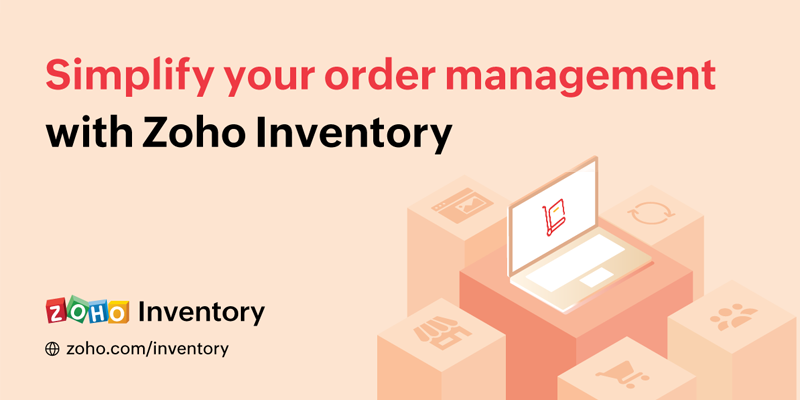Order management refers to receiving all of your customer’s orders and fulfilling each one of them successfully. A typical order management workflow can be split into 3-stages that we talk about in detail in our basics of order management guide. But in brief,
-
Stage 1 is where your customer places an order with your business. For ecommerce orders, this is also the stage where online payments are made.
-
Stage 2 is where the order is actually fulfilled which involves picking the order’s items from the warehouse, packing, and finally shipping them.
-
Stage 3 is dealing with the post-sales procedures like collecting feedback from your customers, and handling returns and refunds.
With all of these processes and subprocesses required for a single order, managing and fulfilling all the orders that you receive manually can become a little tricky as orders pile up. According to the Robotics Business Review, human error is the top cause for order fulfillment problems. Each stage of order management and fulfillment has a lot of scope for various manual errors.
These errors can be difficult, expensive, and time-consuming to rectify or compensate. That’s why we have order management solutions like Zoho Inventory, which can help simplify and organize the entire process, by centralizing all the activity onto one platform. Whether it’s managing your incoming orders, collecting payments, or streamlining your packing and shipping processes, Zoho Inventory can prevent your order management from becoming an overwhelming hassle.
In this article, we’ll be discussing how Zoho Inventory can help you at every stage of the order management journey.
Stage 1: Receiving sales orders
Managing sales orders and payments
Your order management process begins when you receive a sales order from a customer, and it involves collecting the information needed to complete the order.
Collecting and then processing all of this information for a few orders is easy. But imagine doing the same for a 100 orders at a time, without a computerized system in place. It’ll be time consuming, for sure, but data is also bound to get lost or entered incorrectly and this will reflect on the actual order. This means that your customers may not receive exactly what they paid for, at the time they want it delivered.
Zoho Inventory can lighten the load for you here. With centralized data collection, you’re given two options to save your sales orders in the system:
-
You can create new sales orders, add in the data, and then save them in the system.
-
You can integrate your ecommerce platform or online marketplace with the system, and have all your online orders automatically brought in. Zoho Inventory offers a wide range of ecommerce integrations, including Amazon, Etsy, and Shopify, to help you do just that.
Once you’ve added all of your sales orders, you’ll be able to access them in a single page within the system and send them to your customers to check whether the information is correct; sales orders act like an informal way for you to make sure you got their order right. On confirmation, you can then proceed to send them an invoice.
To help you collect payments, Zoho Inventory is also integrated with several major payment gateways, like PayPal, to collect payments quickly and easily. Once you connect to your preferred payment gateway, whenever you send out an invoice, a payment link will be automatically included, which your customers can use to make their payment.
Stage 2: Order fulfillment
Accurate picking
Once your customer’s order has been placed, accepted, and processed in the system, it’s time to fulfill it. The first step of order fulfillment is picking, which means retrieving all of the necessary products for an order from wherever they’ve been stored in your warehouse.
While picking products for a few orders at a time, you can know for sure that you’re picking enough of the right products for each order. But simultaneously picking for many orders can become a little confusing and lead to errors. For instance, if you sell multiple products that are very similar to each other, then a common problem is picking the wrong products—or if the right products have been picked, then there’s a chance that it’s not the right quantity.
To prevent such errors from happening, Zoho Inventory offers the option to put together detailed picklists, which are documents containing information about the items that need to be picked for each order. Each picklist has a:
-
Picklist number
-
Date of picking
-
Assigned picker’s name
-
Name of warehouse
-
Customer name(s)
-
Sales order number(s)
-
Item name(s)
-
SKU
-
Quantity ordered, quantity picked, and quantity to be picked
-
Specifications, if any
With these picklists, warehouse picking staff have sufficient information to make sure that they’re collecting the right quantity of the right products for the right orders from the right location.
Faster packing
Now that you’ve picked all of the products for your sales order, the next step towards order fulfillment is packing.
When packing, it’s important that you use enough material to ensure that your packages can be delivered without breakage or damage—but not overdo it and waste resources and money. Unfortunately, figuring out how to do this for each package may take time, and you don’t want to end up playing Tetris with your boxes and products while trying to find the best way to pack.
Zoho Inventory’s AI-powered, Package Geometry feature offers the perfect solution for this. Package Geometry is a special feature that helps you identify the most optimal packing arrangement for your products. The system first takes the dimensions of each product in an order, as well as the dimensions of your available boxes and containers. Using this data, it then computes 3D simulations of the best ways you can arrange the products in each box, with minimal space wastage, allowing you to choose the best arrangement.
As an added benefit, Zoho Inventory also takes care of auto-generating package numbers and packing slips, based on the information you’ve provided for the order, that you can then attach to your packages. This can speed up the process even further.
Real-time shipment tracking
The final step of order fulfillment is shipping. This involves either directly delivering orders to their respective addresses, if your business offers shipping, or working with a third-party shipping carrier to have your orders delivered by them. In some cases, if the package isn’t delivered by the estimated date of delivery, or it’s misplaced or delivered to the wrong address, rectifying these problems is going to require accurately locating the package.
That’s why Zoho Inventory is integrated with Aftership, to offer real-time shipment tracking. With this integration, you’ll be able to view all of your shipment details on a single screen, update your customers with expected dates of delivery, and send them real-time shipment notifications through email or SMS. Also, Aftership supports over 400 courier services all over the world, so if you’re already partnering with a shipping carrier, you can continue their services with Zoho Inventory.
Stage 3: Post-sales processes
Handle returns and refunds
By this stage, your customer’s order has been accepted, processed into the system, and fulfilled. If all went well and your customer is satisfied with their purchase, then this is the end of that particular order’s lifecycle. If not, then it’s time for the post-sales processes.
This includes collecting and processing returns, and then either issuing a replacement or a refund. Statistically, businesses that make a lot of sales, like popular ecommerce sites, are expected to also receive a lot of return requests. But around the holidays or other times, when there is a sudden spike in sales, many more businesses, ecommerce and others, receive returns. Handling all of these can become a nightmare if you’re unprepared for them.
Luckily, Zoho Inventory supports return material authorization (RMA), also known as sales returns, product returns, and return of goods. Let’s consider a basic scenario to understand how it works:
-
Your business first accepts a customer’s order and their payment, and then successfully fulfills it. Unfortunately, a few days later they realize that they need to return the order, so they place a return request with you.
-
Once you receive the request, you need to first make sure that the items in question are eligible for return.
-
If they are, then you can proceed to open a sales return within Zoho Inventory, which makes a note in the system that you are about to receive a return.
-
Once this is done, you’ll have to collect the returned items, bring them back to your warehouse, and then update the system that you’ve received the items. This will automatically update your inventory levels as well.
-
Now all that’s left to do is to issue the customer a refund for the products they’ve returned, which you can do by sending them a credit note, and accounting for it within the system.
With this organized workflow, handling returns in Zoho Inventory becomes a much smoother process.
When it comes to managing your orders, relying on manual methods is a recipe for disaster, as multiple interconnected processes are involved, which can have a cascading effect on your business:
Orders aren’t processed properly → Customers aren’t happy → Business takes a hit
With Zoho Inventory, you can easily avoid manual errors, simplify some of the mundane tasks involved in order processing, and keep your customers happy by fulfilling their orders accurately and on time. Check out our free trial to learn more!

